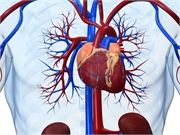For patients referred for RHC, risk for mortality, heart failure up with PVR of ≥2.2 Wood units
MONDAY, Aug. 3, 2020 (HealthDay News) — For patients undergoing right heart catheterization (RHC), the risks for mortality and heart failure are increased with a pulmonary vascular resistance (PVR) of 2.2 Wood units or more, according to a study published online July 27 in The Lancet Respiratory Medicine.
Bradley A. Maron, M.D., from the Veterans Affairs Boston Healthcare System, and colleagues conducted a retrospective cohort study of all patients undergoing RHC in the U.S. Veterans Affairs health care system with at least one year of follow-up. The primary cohort included 40,082 patients, and the analysis focused on patients at risk for pulmonary hypertension based on a mean pulmonary artery pressure (mPAP) of at least 19 mm Hg.
The researchers found that the all-cause mortality hazard for PVR was increased at about 2.2 Wood units compared with a PVR of 1.0 Wood unit when modeled as a continuous variable. When comparing PVR ≥2.2 versus <2.2 Wood units, the adjusted hazard ratio was 1.71 for mortality and 1.27 for heart failure hospitalization among patients with a mPAP of at least 19 mm Hg and pulmonary artery wedge pressure of 15 mm Hg or less. In a validation cohort of 3,699 patients, the adjusted mortality hazard ratio was 1.81.
“We identified a PVR threshold of 2.2 Wood units as clinically meaningful in patients with elevated pulmonary artery pressure, which was consistent across two large at-risk populations,” the authors write.
Several authors disclosed financial ties to the biopharmaceutical and medical technology industries.
Copyright © 2020 HealthDay. All rights reserved.








